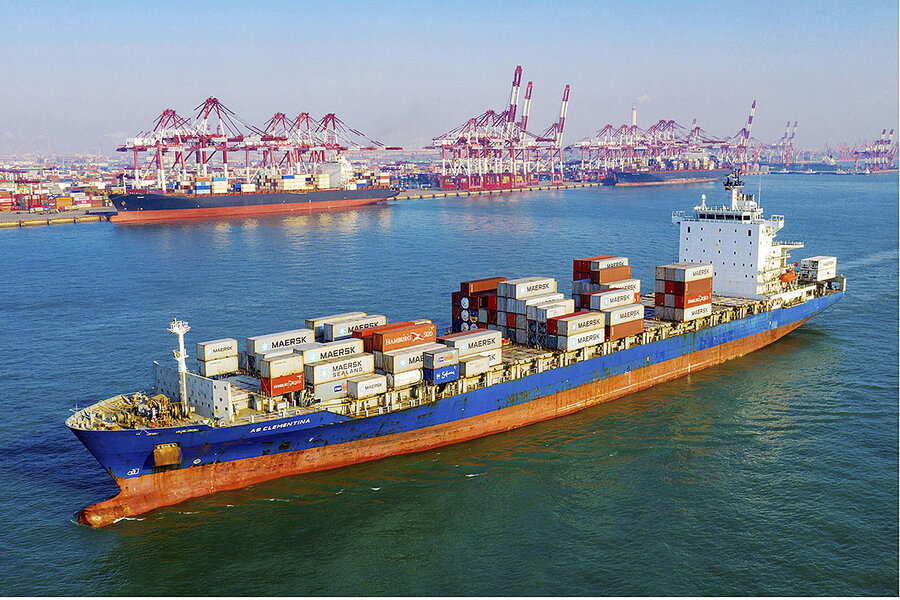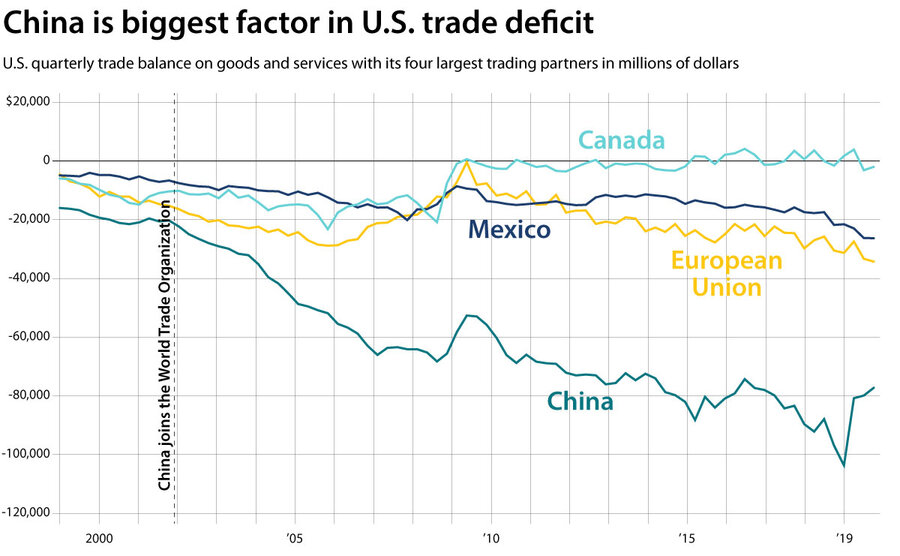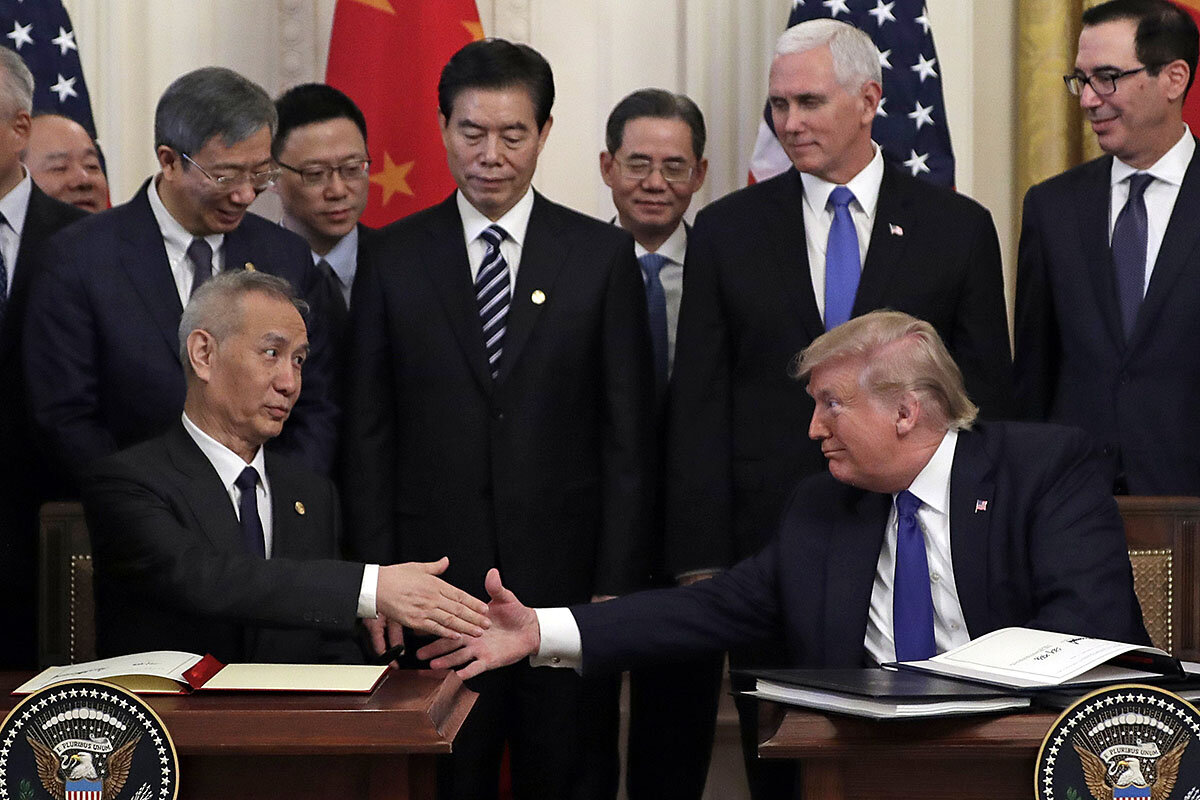A pause, for now: Inside the US-China trade deal
Loading...
In announcing a trade deal Wednesday the United States and China have effectively called a truce after fighting to a standstill.
For now, the tit-for-tat tariff war will be replaced with a kind of armed peace, dubbed “phase one” by President Donald Trump, where both sides will lower some tariffs, but keep others in place.
At an elaborate White House ceremony, President Trump and Chinese Vice Premier Liu He signed a 90-page accord that aims to protect U.S. intellectual property; put an end to forced technology transfer to Chinese partners; reduce Chinese barriers to agricultural imports and financial services; and discourage currency devaluations. China also agreed to buy at least $200 billion worth of U.S. goods and services over the next two years.
Why We Wrote This
A trade war between the world’s largest and second largest economies has been a drag on global growth. President Trump may have reached the limit of what tariffs can achieve in forcing change on China.
That amounts to a win for the president, who has long sought to reverse a yawning trade deficit with China that he blames for job losses in U.S. manufacturing. But the deal also illustrates the limits of his go-it-alone tariff policy. Without a broader set of diplomatic tools, the administration is unlikely to resolve more gnarly issues at the heart of the U.S.-China impasse, including subsidies and policies that favor domestic Chinese companies.
“The tariffs as tactic? This is about as far as they are going to get the U.S.,” says Edward Alden, a senior fellow at the Council on Foreign Relations in Washington. “The tactics in phase two may be different.”
By many accounts, the phase one agreement is a step in the right direction. It not only ends the bilateral escalation in tariffs, it puts in place a number of enforcement mechanisms that will make it harder for either party to renege on what they’ve agreed to. It also sets up the creation of a new dispute-resolution office.
“You have to give the administration credit for having a broad but detailed agreement on many different elements, including having an enforcement arrangement that is specific,” says Scott Kennedy, a China expert at the Center for Strategic & International Studies, a Washington think tank.
From solar panels to steel goods
The conflict began two years ago this month when President Trump imposed tariffs on imported washing machines and solar panels; two months later he targeted steel and aluminum imports. Chinese goods weren’t specifically targeted in either action, but the actions were clearly aimed at China.
The president has long complained that China’s trade practices are unfair and the reason why the U.S. imports $380 billion more in goods and services from China than it sells there. Most economists say the deficit isn’t in itself a bad thing for the U.S. since the lower cost of goods from China is good for U.S. households and businesses. Critics of U.S. trade policy point out that the offshoring of U.S. manufacturing to China and other low-cost producers has decimated many U.S. regions.
In April 2018, Beijing struck back, with 25% tariffs on more than 100 U.S. products, including airplanes and soybeans. The U.S. escalated again in July and so on. By late last year, the Trump administration had penalized a total of $360 billion of Chinese imports and had targeted an additional $160 billion. Similarly, China imposed duties on $110 billion of U.S. goods.
That’s when both sides reached the phase one deal, putting a stop to further escalations. In the new agreement, the U.S. has pledged not to implement the tariff increases it had threatened and also will reduce its Sept. 1 tariffs on Chinese goods from 15% to 7.5% next month.
At the press conference, Mr. Liu reiterated China’s pledge to buy at least $40 billion of American farm products over each of the next two years. The deal’s signing helped drive up U.S. stocks in Wednesday’s trading.
Still, economists doubt China can live up to that $40 billion pledge on agricultural imports, let alone the $200 billion made-in-America bonanza. “There are a lot of people [who are] skeptical,” says Patrick Westhoff, director of the Food and Agricultural Policy Research Institute at the University of Missouri. It’s conceivable that the Chinese could effectively double the nearly $20 billion in U.S. farm goods it bought before 2018, says Mr. Westhoff. But that would mean China freezing out non-U.S. suppliers, potentially triggering trade friction elsewhere.
If reaching the phase one deal proved difficult, reaching a phase two agreement is likely to be orders of magnitude more difficult because the issues involved go to the heart of the U.S.-China dispute, namely, a sharp disagreement on how economies should operate. In the West, increased trade is generally considered a win-win; in China, it takes a back seat to national economic priorities and political oversight of the economy.
So issues such as China’s goals for technological development supported by government subsidies to companies remain unaddressed.
A broader Western agenda
One big question is how the U.S. can keep pressure on the Chinese for a phase two agreement.
One possible sign came Tuesday when the U.S., the European Union, and Japan released a joint statement calling for tighter trade rules on government subsidies to companies – a key point of ongoing friction between China and the West. The issuing of the statement points to the possibility that the administration would try to involve key allies in its push to get China to change its ways.
“This is not a problem that can be solved between China and the U.S. alone,” says Mary Lovely, a professor of economics at Syracuse University and a senior fellow at the Peterson Institute for International Economics. “We need, need, need our allies!”
The next 12 months will be telling, says Mr. Kennedy, since the agreement aims at increasing trade between the two nations. This comes after the tariff war led some U.S. companies to move their operations out of China.








